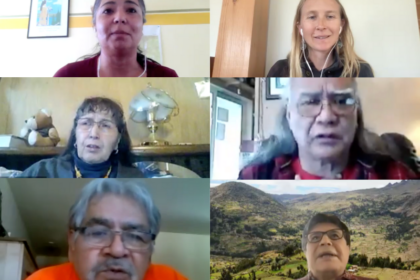UNPACKING “CONSERVATION” PART I: VOICES FROM TURTLE ISLAND
Unpacking “Conservation”: Voices from Turtle Island/North America on Vimeo [FULL WEBINAR RECORDING]
On March 10, 2022, the paradigm clash of the conservation industry and Indigenous Peoples’ management of their home territories was explored by a panel of distinguished Native elders from Turtle Island (North America) in the first round of the Unpacking Jargon series #2on Conservation, Protected Areas and Indigenous Homelands: Voices from Turtle Island/North America, co-hosted by Swift Foundation and First Nations Development Institute.
According to moderator Sonja Swift, Program Advisor to Swift Foundation, the goal of the webinar series is to closely examine the construct or paradigm of conservation as it is typically promoted and understood, which harkens back to European colonization. “The choices that large conservation NGOs tend to make about what to “conserve,” where and how, comes from how they define conservation. Typically, conservation has been promoted by a mindset that has consistently sought to separate people from land.” She emphasized how listening to our elders’ wisdom on the holistic struggles of Indigenous Peoples defending their territories could not be more timely since the United Nations is posed to approve a plan to put a third of Mother Earth’s land and oceans, including Indigenous Peoples’ territories, into protected areas.
The proposed plan, known as the “30×30,” and specifically its promotion of expanding protected areas, “raises serious questions about who is setting the terms, the definitions, and to whose into hands the funding will actually go. In order to live up to this pledge the promoters of it need land. Whose land? Indigenous peoples land. And as we know from past conservation initiatives of scale, this will most likely play out according to the policies and frameworks of the well-funded environmental or conservation NGO’s.” Otherwise known as fortress conservation, this model of conservation has resulted in the forced displacement of tens of millions of Indigenous peoples. The 30×30 plan could potentially result in massive land grabs as well as biodiversity loss since protected areas often allow for mining, oil drilling and logging. You can read the Statement on the 30×30 Protected Areas Framework signed by over 45 philanthropic organizations including the Swift Foundation and First Nations Development Institute here.
Mary Adelzadeh, a member of the Navajo Nation and a Senior Program Officer at First Nations Development Institute, opened the conversation by naming the stark funding disparities that currently exist, sharing some telling statistics: “According to Native Americans in Philanthropy from 2002 to 2016, Native groups receive 0.4 percent of the total Philanthropic funding. Native Americans should be getting five times more in philanthropic support if they received grants in proportion to their census numbers.” She also named the challenges arising as mainstream environmental NGO’s notice the success of tribes and Native communities in protecting their lands, and in turn “many are now growing indigenous focused programming driven by their own priorities and values,” and receiving significant funding for marketing this work. “Such a dynamic creates significant funding inequities and often takes critical resources away from the Native groups.” In response, Mary outlined critical process agreements that are requisite so ENGO’s don’t take all the credit, usurp the funding or disrupt this important work.
Jeannette Armstrong, Ph.D., a traditional knowledge keeper of the Okanagan Nation and founder of the En’owkin Center, the Okanagan Nsyilxcn language and knowledge institution of higher learning of the Syilx Okanagan Nation, contrasted fortress conservation with the holistic conservation of Indigenous Peoples, who tend, defend and “enhance” their territories. From her home in the unceded territories of the Okanagan Nation, Armstrong hailed Native struggles, like that of the Wet’suwet’en and Gitxsan Nations standing in the way of pipelines, as “real conservation.” But she lamented that when Indigenous Peoples struggle to protect an area, “they are not seen as conservationists…they are seen as ‘militants’ and they are criminalized to create this idea of wild Indians at it again.” Armstrong called for deconstructing mainstream conservation because real conservation is “not just about the aesthetics of a place to visit as a tourist. For us it is going out there, it is finding the medicines and understanding the names of every living thing that is there, connecting with them in a spiritual way and cultural way, singing those songs when we harvest and bringing all the different foods together in our ceremonies and sharing with our peoples.” She pointed out how “success stories” of Indigenous people protecting lands, such as tribal parks or heritage sites, came as a result of deep struggle, years of work and significant funds spent on legal costs. “All those decisions weren’t done with willingness” by the state or, as is often the case, environmental organizations. To this point she lamented the disparity in funding: “Billions of dollars are being poured into conservation, why not for us? There is a big bias, that has to be dispelled and changed by the funders.”
Marlowe Sam, Ph.D., Wenatchi/Lakes descendant from the Colville Confederated Tribes of Washington State, acknowledged matter-of-factly: “Our peoples have been land managers for tens of thousands of years prior to arrival of Europeans.” He also pointed out how Europeans denuded forests across their own homelands before coming to the Americas, and undergirded the misconception of the Americas as “untouched” and “wild” – narratives of misunderstanding that effectively prepared incoming settlers for the project of colonization. Addressing the idea of conservation, which arose out of colonization, and the way it has been “misconstrued and misunderstood” in terms of intent and purpose, Sam offered a synthesis of the actual goal: “a balanced state of harmony between human beings and natural world environment.” Herein lies the paradigm shift, harmony between rather than separate from. And yet, “there seems to be a common practice and policy for the exclusion of Indigenous Peoples from these protected areas.” What does it mean, Sam asked, when Indigenous peoples, as contributors to the enhancement of biodiversity in these lands, are excluded? “It means these lands are suffering. They will never return to a state when we were its managers.”
Eddie Knight, Coastal Yuki, Little Lake, Shanel, Yokaya, Pomo, who serves as the Coyote Valley Historic Preservation officer and is one of the main organizers of the Blues Beach land transfer, explained the concept of conservation in his understanding and experience as simply an act of conserving use of resources for non-natives. “We native people have been harvesting and fishing and hunting – we have been practicing our way of conservation and our methods – and to me it is why we still have this stuff today.” As evidenced the world over, the dualistic notion that undergirds mainstream conservation of protecting some lands implies sacrificing others, which goes against the methodology Knight speaks to – one of balance. The Blues Beach land transfer itself is a landmark struggle spanning two decades that will be not only the first restitution of Native homelands in the State of California, but also the first on the coast. Harkening to Jeannette’s points, it has been a struggle, without willingness. Knight’s anecdotes about the frustrating dealings with government agencies to achieve the transfer, contrasted with his delighted reminiscing about his grandfather and uncles teaching him how to fish to ensure enduring abundance. In response to state agencies claiming consultation and a transfer plan according to their process, without even speaking to the tribes, the three tribes involved in the land return have created their own consultation process, on their terms.
In closing, Jeannette Armstrong stated poignantly “we can make changes,” and how she takes heart in this. Marlowe Sam reflected how it is not enough to struggle to get the Land Back!, an increasingly resonant demand of the Native movement in Canada and the US, but how one needs to also get back to the land. “I think there needs to be a much deeper commitment towards going back to the land and truly understanding the relationships that are there. The animals need for us to go back to them so they can talk to us in our dreams and inform us.” Eddie Knight reaffirmed the necessity that consultation processes be led and determined by the Native people being consulted, and shared how on another land base a Northern California tribe bought back from the state, they are bringing their youth every weekend to be on the land to learn. Alejandro Argumedo, Swift Foundation’s Director of Programs, reminded us that at 5% of the world’s population, Indigenous peoples territories hold 80% of the world’s biodiversity. This increasingly referenced statistic speaks for itself, but it is the stories, the knowledge, protocols and skills such as we heard from these speakers that need to be listened to and heeded.


